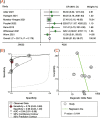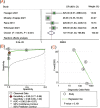Serum neurofilament light chain as a predictive marker of neurologic outcome after cardiac arrest: a meta-analysis
- PMID: 37061702
- PMCID: PMC10105388
- DOI: 10.1186/s12872-023-03220-z
Serum neurofilament light chain as a predictive marker of neurologic outcome after cardiac arrest: a meta-analysis
Abstract
Objective: Recently, an increasing number of studies have suggested using serum neurofilament light (NfL) chain to predict the neurologic outcome after cardiac arrest. However, the predictive ability of this approach remains inconclusive. Meta-analysis was performed on related studies to assess the ability of serum NfL to predict the neurologic outcome after cardiac arrest.
Materials and methods: PubMed, ScienceDirect and Embase were systematically searched from the date of their inception until June 2022. Data were extracted to calculate the area under the receiver operating characteristic curve (AUC), the sensitivity, the specificity and the publication bias to evaluate the predictive power of serum NfL using Stata 14.0.
Results: Nine studies were included in the present meta-analysis. Seven studies involving 1296 participants reported serum NfL 24 h post arrest for predicting the neurological outcome, and the AUC was 0.92 (77% sensitivity and 96% specificity). Seven studies involving 1020 participants reported serum NfL 48 h post arrest for predicting the neurological outcome, and the AUC was 0.94 (78% sensitivity and 98% specificity). Four studies involving 804 participants reported serum NfL 72 h post arrest for predicting the neurological outcome, and the AUC was 0.96 (90% sensitivity and 98% specificity). No significant publication bias was observed among the included studies.
Conclusion: The present meta-analysis results support the potential use of serum NfL as an early biomarker of neurologic outcome, especially 72 h post arrest.
Keywords: Brain injury; Cardiac arrest; Cardiopulmonary resuscitation; Neurofilament light.
© 2023. The Author(s).
Conflict of interest statement
The authors declare no conflict of interest.
Figures





Similar articles
-
Prediction of Neurological Recovery After Cardiac Arrest Using Neurofilament Light Chain is Improved by a Proteomics-Based Multimarker Panel.Neurocrit Care. 2022 Apr;36(2):434-440. doi: 10.1007/s12028-021-01321-1. Epub 2021 Aug 3. Neurocrit Care. 2022. PMID: 34342833
-
Plasma neurofilament light is a predictor of neurological outcome 12 h after cardiac arrest.Crit Care. 2023 Feb 24;27(1):74. doi: 10.1186/s13054-023-04355-3. Crit Care. 2023. PMID: 36829239 Free PMC article.
-
Serum neurofilament measurement improves clinical risk scores for outcome prediction after cardiac arrest: results of a prospective study.Crit Care. 2021 Jan 20;25(1):32. doi: 10.1186/s13054-021-03459-y. Crit Care. 2021. PMID: 33472689 Free PMC article.
-
Neuroprognostication value of serum neurofilament light chain for out-of-hospital cardiac arrest: A systematic review and meta-analysis.PLoS One. 2023 Sep 15;18(9):e0290619. doi: 10.1371/journal.pone.0290619. eCollection 2023. PLoS One. 2023. PMID: 37713399 Free PMC article.
-
Neurologic Prognostication After Cardiac Arrest Using Brain Biomarkers: A Systematic Review and Meta-analysis.JAMA Neurol. 2022 Apr 1;79(4):390-398. doi: 10.1001/jamaneurol.2021.5598. JAMA Neurol. 2022. PMID: 35226054 Free PMC article.
Cited by
-
Predictive Performance of Neuron-Specific Enolase (NSE) for Survival after Resuscitation from Cardiac Arrest: A Systematic Review and Meta-Analysis.J Clin Med. 2023 Dec 13;12(24):7655. doi: 10.3390/jcm12247655. J Clin Med. 2023. PMID: 38137724 Free PMC article. Review.
-
Serum neurofilament light chain as a sensitive biomarker for neuromonitoring during extracorporeal membrane oxygenation.Sci Rep. 2024 Sep 9;14(1):20956. doi: 10.1038/s41598-024-71603-z. Sci Rep. 2024. PMID: 39251725 Free PMC article.
-
Development and validation of prediction models for death within 6 months after cardiac arrest.Front Cardiovasc Med. 2024 Nov 28;11:1469801. doi: 10.3389/fcvm.2024.1469801. eCollection 2024. Front Cardiovasc Med. 2024. PMID: 39669409 Free PMC article.
-
Neurofilaments as biomarkers in neurological disorders - towards clinical application.Nat Rev Neurol. 2024 May;20(5):269-287. doi: 10.1038/s41582-024-00955-x. Epub 2024 Apr 12. Nat Rev Neurol. 2024. PMID: 38609644 Review.
-
Biomarkers Unveiling the Interplay of Mind, Nervous System, and Immunity.Methods Mol Biol. 2025;2868:73-90. doi: 10.1007/978-1-0716-4200-9_5. Methods Mol Biol. 2025. PMID: 39546226 Review.
References
Publication types
MeSH terms
Substances
LinkOut - more resources
Full Text Sources
Medical

